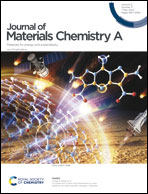Establishing the correlation between Rashba spin splitting and HER activity enhancement in Janus structures†
Abstract
The Rashba effect is an emerging phenomenon in the electronic structure regime, where valence band maxima and conduction band minima split across the momentum space and subsequently create an intermediate electronic state specifically for non-centrosymmetric structures with heavy elements as the constituents that have inherent relativistic spin–orbit coupling (SOC). This introduces not only a delay in the electron–hole recombination, but also the electrons at the intermediate state below the conduction band could further trigger the hydrogen evolution reaction (HER) through proton reduction. The subsequent tuning of the splitting would certainly have a repercussion on both the charge carrier recombination rate and the possibility of electrons in the intermediate band beneath the conduction band. The second effect could enhance the activity of HER and hence the correlation between Rashba band splitting and HER activity could be established in non-centrosymmetric Janus monolayers. In this work, we have envisaged the influence of bi-axial strain on the Rashba effect in the 2D Janus BiClS monolayer. We have found that the bi-axial strain could manipulate the strength of Rashba spin splitting at the conduction band minimum (CBM). To confirm Rashba-type splitting in pristine and strained BiClS monolayers, we have determined the spin-texture around the band splitting regime at the CBM around high symmetry point Γ and correlate the splitting value with catalytic activity corresponding to the hydrogen evolution reaction (HER) mechanism.



 Please wait while we load your content...
Please wait while we load your content...